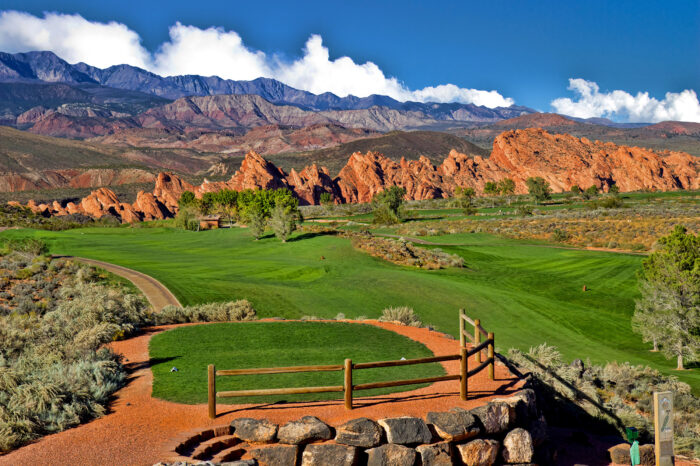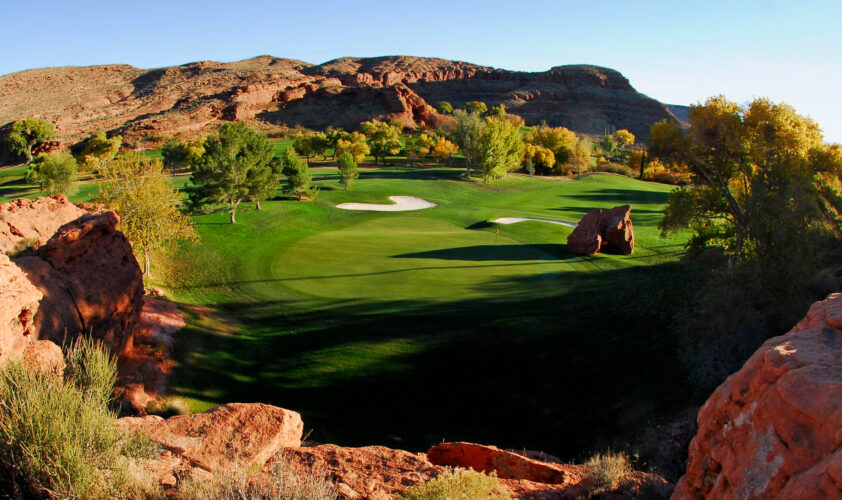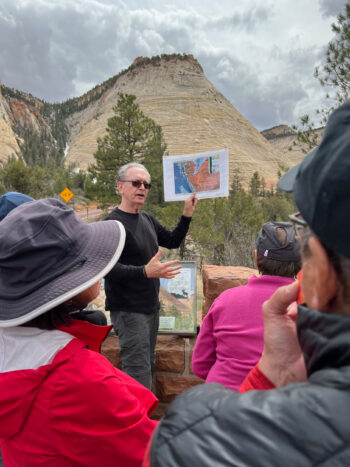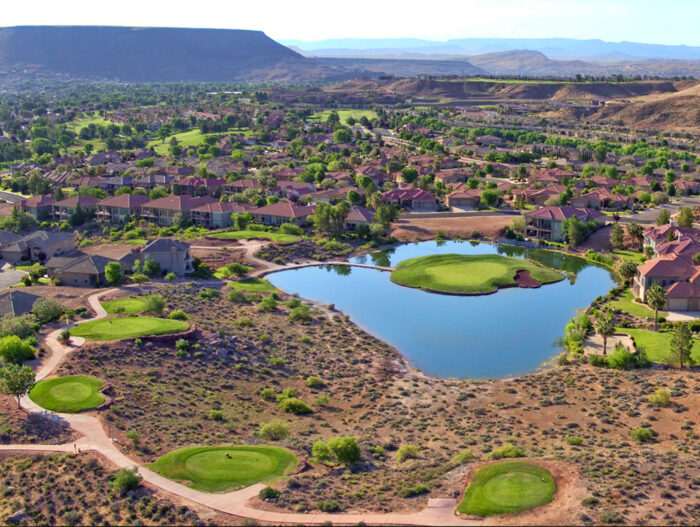(Above: Owned by the City of St. George, Red Hills Golf Course is surrounded by Zion National Park and the Pine Mountain Valley range.)
Utah’s ‘Road Scholar’ golf school offers next-level instruction in an unbelievable setting
I hadn’t thought myself a scholar in a very long time (in truth, I wasn’t much of a scholar back when I was supposed to be), but that couldn’t be said for one week this spring. Fully embracing the myth that you are never too old to learn new tricks, I headed for southern Utah where I found myself in the company of two dozen genuine scholars who had all declared majors in putting and chipping – with a minor in rocks.
My companions were Road Scholars, to be precise, golfers from around the country who had similarly signed up for a program that would combine golf instruction with play on four courses, interrupted by a geologist-led excursion to nearby Zion National Park.
When another trip my wife and I had considered taking fell through last fall, we were drawn to this package because it promised “The Best Golf of Your Life – Four Courses in Red Rock Country.” Golf was an easy sell, but throw in the chance to see a bucket-list national park like Zion, an itch we had long ached to scratch, and it didn’t take much to get us to sign on.
In April we flew to Las Vegas, took the St. George shuttle two hours into Utah and were reunited with our golf clubs, which we had shipped on ahead. It would be our first experience with Road Scholar, the non-profit organization that offers thousands of educational trips annually around the world, primarily geared toward older adults. (It was formerly called Elderhostel.) But we were familiar with Road Scholar by reputation; friends have taken Road Scholar trips, and I once spoke to a Road Scholar group visiting my hometown of Bayfield where one couple was on their 50th Scholar trip. That seemed something of an endorsement.
St. George, a swiftly growing city of some 100,000 residents, is a hotbed for Road Scholar programs that are offered in conjunction with Utah Tech University. The golf-national park package that we had chosen is offered eight times a year (and always sells out), while other St. George-based programs include 10-day tours of Utah’s five national parks and various hiking packages.
Our seven-day package included six nights of lodging, 17 meals, transportation (not in a yellow school bus but in a Utah Tech luxury motor coach), park admission, golf and carts.
St. George is a popular destination for visitors to Zion, which attracts millions of hikers, campers and sightseers annually, but golf is another major draw. With the 2022 opening of Black Desert Resort Golf Course in nearby Ivins, the last track designed by Tom Weiskopf before his death, the area boasts 14 golf courses, plus another seven an hour away in Mesquite, Nevada.
“That’s a lot of golf courses,” said Rob Krieger, PGA director of instructionat South- gate Golf Club, one of four we would play. “That’s a lot of people coming here for golf.”
Including our two dozen Scholars who had come from far and wide, from Vancouver and Sequim in Washington to Ypsilanti in Michigan, from Bethel in Maine to Smithfield in North Carolina. Wisconsin was represented by my wife, Barb, and me and by Barbie Papamarcos of Grafton.
At our orientation dinner the first night, we went around the room to explain a bit about ourselves as well as to relate how we had come to golf, our approximate handicaps and what we hoped to get from a week of instruction. Some of us had played golf for a very long time, while others had more recently taken the game up in retirement or during the pandemic. Our goals were predictably hopeful, if expectations also chastened by experience. Golf, remember. At Southgate, one of four St. George municipal courses, we were split into four groups, the better to tailor instruction to talent (real or perceived.) We began with a refresher on the basics of grip, stance and pre-shot routine before taking clubs in hand. While one group worked on short pitch shots, another went to work on bunker rescues. Another group worked on putting drills. Then, after lunch, it was time for golf. Our first course was Dixie Red Hills (St. George was long known as Utah’s Dixie because it was founded as a cotton mission under the direction of Brigham Young), a dandy nine-hole muni that comes by its name honestly. Set amidst distractingly spectacular red rocks and with greens quick enough to embarrass the careless, Dixie proved a good test of how much we had paid attention during morning lessons. When I four-putted the sloping first hole I acknowledged I needed to do a little more homework — and didn’t that remind me of my college days — but it was a terrific introduction to St. George golf.

Sky Mountain Golf Course is another magnificent muni, owned by the City of Hurricane near St. George.
The second morning we returned to Southgate for work on irons and hybrids, tee shots and fairway metals and more putting and chipping. Golf that afternoon was at Sunbrook Golf Course, a 27-hole layout that was once voted as the top course in Utah. Water was the story here, from the pretty Santa Clara River to fairways dotted with lakes, waterfalls and rock walls.
And then it was on to day three, for one more morning of instruction from our PGA professionals Krieger, Cam Hamill, Rick Allison and Mike Sandberg.
“So after today,” warned group leader and bus driver Paul Peterson, “no more excuses.” Hey, nobody said our swings were going to be on the quiz. But dutiful Scholars all, we went over recent rule changes before head- ing out with instructors for more work on chipping, putting and other essentials. Golf in the afternoon was also at Southgate, where the 18 holes come with views of the scenic Tonaquint Mountain and the St. George area.
After three straight days of golf, most of us were ready for something different, and in this case it was the much anticipated Zion National Park, one of the most glorious and majestic of America’s public spaces. We prepped for our Thursday visit by gathering on Wednesday evening for a primer from a funny and entertaining geologist (no, really!) named Marc Deshowitz, who explained how the incredible canyon was formed over some 275 million years of geologic activity that produced today’s sedimentary cliffs, arches and towering canyons, all bisected by the famous Virgin River. There was talk of tectonic plating, volcanic activity, dinosaur tracks and numerous mentions of Navajo sandstone, the whitish layer that so nicely sets off the more dramatic red rocks. While much of that passed over my head, if I’m honest, even I was impressed when Deshowitz pointed out every individual layer on every canyon wall or mountain told a different chapter in the earth’s history.
What a story!
Deshowitz continued to entertain on the bus ride to Zion the next day. In hopes of sounding scholarly, and not at all committing mischief (yeah, right) I asked how the Virgin River got its name. Deshowitz paused for a moment, then asked which explanation I wanted – and how racy? Bring it, I said.
“For the blessed Virgin, of course,” he said. But Paul, who was driving, said there are also some who believe it’s “because nobody’s ever seen its bottom.”
And yet others, Deshowitz said, say “it’s because it runs just fast enough.”
I love geology.
As it turned out, the snowmelt-fed Virgin was not just running but raging through the high-walled canyon. One popular hike at Zion is to walk “The Narrows” between two cliffs by wading up the shallow river, but that hike was closed because of the force of the water. We hiked the two-mile trail along the river, an easy-enough walk that brought memorable views of waterfalls, weeping walls and stunning rock formations.
“It’s a great day at the park,” Deshowitz said as we toured further in the afternoon.
“A very special place.”
And, our last day, we turned again to golf. “We saved the best for last,” said Peterson as we headed for Sky Mountain Golf Course about 15 miles from downtown, and boy howdy, had they ever. The course is described on its website as “one of the most picturesque and beautiful golf locations in the world” and I suspect not one of our group would disagree with a word of that. Surrounded by Zion National Park and the snow-capped Pine Valley Mountain range, the 18 holes offered one jaw-dropping view after another for our final round. Even the driving range, where it appeared out shots were headed for beautiful mountains in the distance, demanded photo after photo. It was that rare golf course where “wow!” was heard more often than “dammit” and we pretty much wore out wow well before the last hole.
As Deshowitz might have said, had he joined us, “a very special place.”
On our last night we gathered for one more group dinner at a nearby chop house. Awards were presented for a few contests during our days of play, one of our group was presented with a broken watch to reflect how often he had almost missed the bus and Peterson handed out a sheet with more than 20 swing thoughts ranging from “don’t jump” to “clear the hips” to “back to the target” and “don’t shank,” enough swing nonsense to undo our three days of helpful instruction. And then it was back to the hotel for one more sleep but not before hugs and hand- shakes with new friends who had been only strangers just days before. Our trip had proven the immersive experience we had hoped, and not only for golf.
For more information, or to order a catalog of all Road Scholar programs around the world, visit roadscholar.org. For more information about Zion National Park, visit nps.gov/zion.



 ';
';
 ';
';
 ';
';
 ';
';